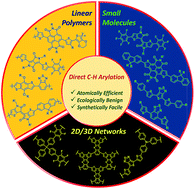Direct C–H arylation: a “Greener” approach towards facile synthesis of organic semiconducting molecules and polymers
Abstract
Organic π-conjugated small molecules and polymers, owing to their light weight, solution processability, mechanical flexibility, and large synthetic variety of finely tunable structures and properties, are promising semiconducting materials for a new generation of optoelectronic devices such as light-emitting diodes (LEDs), field-effect transistors (FETs), photovoltaic devices and sensors. A vast library of π-conjugated systems have been synthesized through conventional tools of coupling (e.g. Suzuki coupling, Stille coupling) and have been used in the fabrication of organic optoelectronic devices. In recent years an emerging synthetic technique called direct C–H arylation has been extensively studied as a facile, atom-efficient and environmentally benign pathway for the synthesis of conjugated polymers and small molecules. C–C bond formation between two heteroaryls can be carried out via the activation of C–H bonds in a transition-metal catalytic cycle, thereby overcoming additional pre-functionalization steps involving toxic reagents. Direct arylation has been applied to a broad range of monomers and its reaction conditions have been optimized to produce defect-free polymers as well as small molecules that exhibit performances comparable with those made from conventional reactions. In this review, we summarize the recent progress in the synthesis of conjugated small molecules, linear polymers and porous polymers by direct C–H arylation. In particular, small molecules and linear polymers based on benzothiadiazole (BT), diketopyrrolopyrrole (DPP), napththalenediimide (NDI), isoindigo (IG), thienoisoindigo (TIIG) and thienothiadiazole (TTD) are discussed in detail. Device performances of some representative polymers synthesized via direct arylation polymerization (DAP) in FETs and bulk heterojunction solar cells are summarized. We finally discuss the present challenges and perspectives of DAP towards future “greener” and more industrially scalable synthesis of π-conjugated semiconducting polymers for a variety of applications.

- This article is part of the themed collections: Recent Review Articles and Journal of Materials Chemistry A Emerging Investigators


 Please wait while we load your content...
Please wait while we load your content...